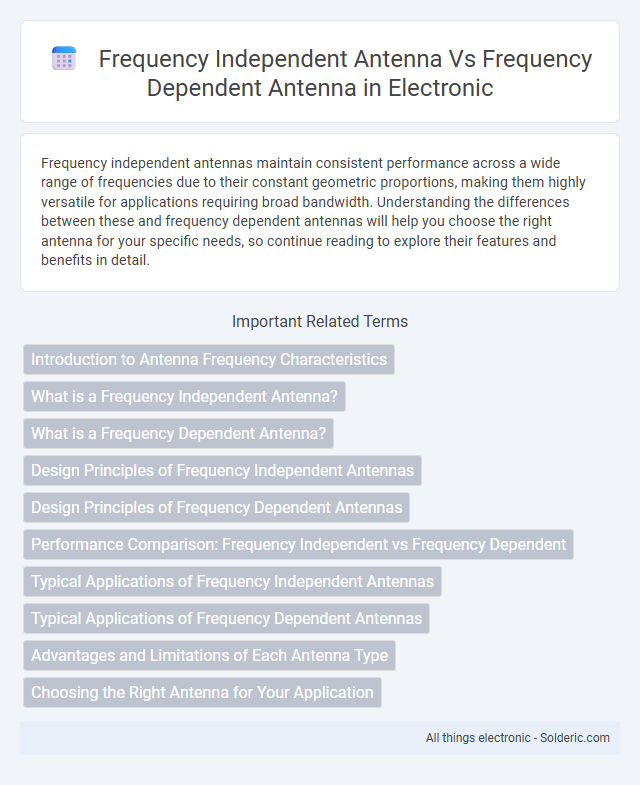Frequency independent antennas maintain consistent performance across a wide range of frequencies due to their constant geometric proportions, making them highly versatile for applications requiring broad bandwidth. Understanding the differences between these and frequency dependent antennas will help you choose the right antenna for your specific needs, so continue reading to explore their features and benefits in detail.
Comparison Table
| Feature | Frequency Independent Antenna | Frequency Dependent Antenna |
|---|---|---|
| Operating Frequency | Wideband coverage, operates efficiently over a broad frequency range | Narrowband coverage, optimized for specific frequency or small range |
| Design | Geometry based, often self-similar structures (e.g., log-periodic, spiral) | Resonant structures designed for particular frequency (e.g., dipole, patch) |
| Performance Stability | Stable radiation pattern and impedance across frequencies | Performance varies with frequency, optimal only near resonance |
| Applications | Broadband communication, surveillance, direction finding | Radio broadcasting, cellular, radar with fixed frequency bands |
| Size | Antenna size changes with frequency ratio, often larger | Size typically fixed and proportional to operating wavelength |
| Impedance Matching | Maintains impedance match over wide frequency range | Impedance match good only at resonant frequency |
Introduction to Antenna Frequency Characteristics
Frequency independent antennas maintain consistent radiation patterns, impedance, and gain across a wide range of frequencies, enabling versatile performance in broadband applications. Frequency dependent antennas exhibit variations in their radiation characteristics, impedance, and efficiency as operational frequency changes, which can limit effectiveness to narrow frequency bands. Understanding these frequency characteristics is essential for choosing antennas suitable for applications demanding stable performance across diverse frequency spectrums or specific frequency targeting.
What is a Frequency Independent Antenna?
A frequency independent antenna maintains consistent performance characteristics, such as radiation pattern and impedance, across a broad range of frequencies. Its design relies on geometric proportions that scale with wavelength, enabling stable operation without the need for retuning or adjustment. Common examples include log-periodic and spiral antennas, which provide versatile solutions for wideband communication systems.
What is a Frequency Dependent Antenna?
A frequency dependent antenna operates efficiently only within a specific frequency range, meaning its performance such as gain, impedance, and radiation pattern varies significantly outside that range. These antennas are designed to match precise frequencies, making them ideal for applications where bandwidth is narrow and stable resonance is critical. Understanding the limitations of your antenna's frequency dependence can help optimize signal quality and system reliability.
Design Principles of Frequency Independent Antennas
Frequency independent antennas are designed based on the principle that their performance characteristics, such as impedance and radiation pattern, remain stable across a wide range of frequencies. These antennas often use self-similar shapes like logarithmic spirals or tapered biconical structures to achieve consistent electrical properties regardless of the wavelength. The geometric scaling inherent in frequency independent antenna designs ensures broadband operation, enabling applications in communications requiring multi-band or wideband performance.
Design Principles of Frequency Dependent Antennas
Frequency dependent antennas are designed based on resonant principles where their electrical length matches specific wavelengths, resulting in optimal performance only at targeted frequency bands. These designs rely heavily on physical dimensions and geometrical configurations, such as dipoles, loops, or patch antennas, which naturally vary their impedance and radiation patterns with frequency. Material selection and element spacing are critical factors, as they influence bandwidth, gain, and efficiency within the desired frequency range.
Performance Comparison: Frequency Independent vs Frequency Dependent
Frequency independent antennas maintain consistent radiation patterns and impedance across a wide frequency range, ensuring stable performance for broadband applications. Frequency dependent antennas exhibit variations in gain, bandwidth, and radiation characteristics as operating frequency changes, which may limit their effectiveness for multi-band use. Your choice depends on application requirements: frequency independent antennas provide reliable performance for diverse frequencies, while frequency dependent antennas might offer optimized efficiency at specific bands.
Typical Applications of Frequency Independent Antennas
Frequency independent antennas, such as log-periodic and spiral antennas, are widely used in applications requiring wideband performance and consistent radiation characteristics across a broad frequency range, including surveillance, electronic warfare, and broadband communication systems. These antennas are crucial in radar systems and spectrum monitoring where frequency agility and stable impedance are essential for reliable operation. Their capability to maintain constant performance over multiple octaves makes them ideal for test and measurement equipment and multifunctional wireless devices.
Typical Applications of Frequency Dependent Antennas
Frequency dependent antennas are commonly used in applications such as radio broadcasting, where specific frequency bands require optimized reception and transmission. They are essential in mobile communication devices, including smartphones and walkie-talkies, which operate within fixed frequency ranges to ensure clear signal quality. Additionally, frequency dependent antennas are critical in radar systems, enabling precise detection and tracking by focusing on designated frequency bands.
Advantages and Limitations of Each Antenna Type
Frequency independent antennas offer the advantage of consistent performance across a wide range of frequencies, making them ideal for applications requiring broadband coverage and minimal signal distortion. However, they often have more complex designs and can be larger or less efficient at any single frequency compared to frequency dependent antennas. Frequency dependent antennas provide optimized efficiency and gain at specific frequencies, which enhances signal strength and clarity but limits their versatility and requires adjustments or replacements for multi-band use.
Choosing the Right Antenna for Your Application
Frequency independent antennas maintain consistent performance across a wide range of frequencies, making them ideal for applications requiring broad bandwidth, such as wideband communication systems and surveillance. Frequency dependent antennas are optimized for specific frequency bands, providing enhanced gain and efficiency, suitable for targeted applications like fixed-frequency transmitters and receivers. Selecting the right antenna hinges on the required frequency range, bandwidth, and application-specific performance criteria to ensure optimal signal clarity and system reliability.
frequency independent antenna vs frequency dependent antenna Infographic

 solderic.com
solderic.com